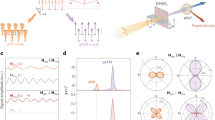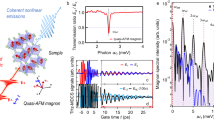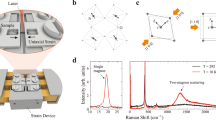Abstract
Magnons are quantized collective spin-wave excitations in magnetically ordered materials. Revealing the interactions among these collective modes is crucial for the understanding of fundamental many-body effects in such systems and the development of high-speed information transport and processing devices based on them. Nevertheless, identifying couplings between individual magnon modes remains a long-standing challenge. Here we demonstrate spectroscopic fingerprints of anharmonic coupling between distinct magnon modes in an antiferromagnet, as evidenced by coherent photon emission at the sum and difference frequencies of the two modes. This discovery is enabled by driving two magnon modes coherently with a pair of tailored terahertz fields and then disentangling a mixture of nonlinear responses with different origins. Our approach provides a route for generating nonlinear magnon–magnon mixing.
This is a preview of subscription content, access via your institution
Access options
Access Nature and 54 other Nature Portfolio journals
Get Nature+, our best-value online-access subscription
$29.99 / 30 days
cancel any time
Subscribe to this journal
Receive 12 print issues and online access
$209.00 per year
only $17.42 per issue
Buy this article
- Purchase on Springer Link
- Instant access to full article PDF
Prices may be subject to local taxes which are calculated during checkout




Similar content being viewed by others
Data availability
Source data are provided with this paper. All other data that support the findings of this study are available from the corresponding authors on reasonable request.
Code availability
The codes used to perform the simulations and to analyse the data in this work are available from the corresponding authors upon request.
References
Turner, D. B. & Nelson, K. A. Coherent measurements of high-order electronic correlations in quantum wells. Nature 466, 1089–1092 (2010).
Först, M. et al. Nonlinear phononics as an ultrafast route to lattice control. Nat. Phys. 7, 854–856 (2011).
Kozina, M. et al. Terahertz-driven phonon upconversion in SrTiO3. Nat. Phys. 15, 387–392 (2019).
Disa, A. S. et al. Polarizing an antiferromagnet by optical engineering of the crystal field. Nat. Phys. 16, 937–941 (2020).
Mashkovich, E. A. et al. Terahertz light-driven coupling of antiferromagnetic spins to lattice. Science 374, 1608–1611 (2021).
Bae, Y. J. et al. Exciton-coupled coherent magnons in a 2D semiconductor. Nature 609, 282–286 (2022).
Bethe, H. Zur theorie der metalle. Z. Phys. 71, 205–226 (1931).
Wortis, M. Bound states of two spin waves in the Heisenberg ferromagnet. Phys. Rev. 132, 85 (1963).
Bai, X. et al. Hybridized quadrupolar excitations in the spin-anisotropic frustrated magnet FeI2. Nat. Phys. 17, 467–472 (2021).
Demokritov, S. O. et al. Bose–Einstein condensation of quasi-equilibrium magnons at room temperature under pumping. Nature 443, 430–433 (2006).
Borisenko, I. et al. Direct evidence of spatial stability of Bose–Einstein condensate of magnons. Nat. Commun. 11, 1–7 (2020).
Pirro, P., Vasyuchka, V. I., Serga, A. A. & Hillebrands, B. Advances in coherent magnonics. Nat. Rev. Mater. 6, 1114–1135 (2021).
Li, J., Yang, C.-J., Mondal, R., Tzschaschel, C. & Pal, S. A perspective on nonlinearities in coherent magnetization dynamics. Appl. Phys. Lett. 120, 050501 (2022).
Wang, Z. et al. Magnonic frequency comb through nonlinear magnon–skyrmion scattering. Phys. Rev. Lett. 127, 037202 (2021).
Carmiggelt, J. J. et al. Broadband microwave detection using electron spins in a hybrid diamond-magnet sensor chip. Nat. Commun. 14, 490 (2023).
Haus, H. A. & Huang, W. Coupled-mode theory. Proc. IEEE 79, 1505–1518 (1991).
Boyd, R. W., Gaeta, A. L. & Giese, E. in Springer Handbook of Atomic, Molecular, and Optical Physics (ed Drake, G.W.F.) 1097–1110 (Springer, 2008).
MacNeill, D. et al. Gigahertz frequency antiferromagnetic resonance and strong magnon–magnon coupling in the layered crystal CrCl3. Phys. Rev. Lett. 123, 047204 (2019).
Makihara, T. et al. Ultrastrong magnon–magnon coupling dominated by antiresonant interactions. Nat. Commun. 12, 3115 (2021).
Lee, O. et al. Nonlinear magnon polaritons. Phys. Rev. Lett. 130, 046703 (2023).
Songvilay, M. et al. Anharmonic magnon excitations in noncollinear and charge-ordered RbFe2+Fe3+F6. Phys. Rev. Lett. 121, 087201 (2018).
Kampfrath, T. et al. Coherent terahertz control of antiferromagnetic spin waves. Nat. Photonics 5, 31–34 (2011).
Teo, S. M., Ofori-Okai, B. K., Werley, C. A. & Nelson, K. A. Single-shot THz detection techniques optimized for multidimensional THz spectroscopy. Rev. Sci. Instrum. 86, 051301 (2015).
Gao, F. Y., Zhang, Z., Liu, Z.-J. & Nelson, K. A. High-speed two-dimensional terahertz spectroscopy with echelon-based shot-to-shot balanced detection. Opt. Lett. 47, 3479–3482 (2022).
Dzyaloshinsky, I. A thermodynamic theory of "weak" ferromagnetism of antiferromagnetics. J. Phys. Chem. Solids 4, 241–255 (1958).
Moriya, T. Anisotropic superexchange interaction and weak ferromagnetism. Phys. Rev. 120, 91 (1960).
Lu, J. et al. Coherent two-dimensional terahertz magnetic resonance spectroscopy of collective spin waves. Phys. Rev. Lett. 118, 207204 (2017).
Yamaguchi, K., Nakajima, M. & Suemoto, T. Coherent control of spin precession motion with impulsive magnetic fields of half-cycle terahertz radiation. Phys. Rev. Lett. 105, 237201 (2010).
Jin, Z. et al. Single-pulse terahertz coherent control of spin resonance in the canted antiferromagnet YFeO3, mediated by dielectric anisotropy. Phys. Rev. B 87, 094422 (2013).
Zhang, Z. et al. Terahertz field-driven magnon upconversion in an antiferromagnet. Nat. Phys. https://doi.org/10.1038/s41567-023-02350-7 (2024).
Khalil, M. & Tokmakoff, A. Signatures of vibrational interactions in coherent two-dimensional infrared spectroscopy. Chem. Phys. 266, 213–230 (2001).
Singh, R. et al. Polarization-dependent exciton linewidth in semiconductor quantum wells: A consequence of bosonic nature of excitons. Phys. Rev. B 94, 081304 (2016).
Stone, K. W. et al. Two-quantum 2D FT electronic spectroscopy of biexcitons in GaAs quantum wells. Science 324, 1169–1173 (2009).
Mai, T. T. et al. Magnon–phonon hybridization in 2D antiferromagnet MnPSe3. Sci. Adv. 7, eabj3106 (2021).
Liu, S. et al. Direct observation of magnon–phonon strong coupling in two-dimensional antiferromagnet at high magnetic fields. Phys. Rev. Lett. 127, 097401 (2021).
Cui, J. et al. Chirality selective magnon–phonon hybridization and magnon-induced chiral phonons in a layered zigzag antiferromagnet. Nat. Commun. 14, 3396 (2023).
Kubacka, T. et al. Large-amplitude spin dynamics driven by a THz pulse in resonance with an electromagnon. Science 343, 1333–1336 (2014).
Wan, Y. & Armitage, N. Resolving continua of fractional excitations by spinon echo in THz 2D coherent spectroscopy. Phys. Rev. Lett. 122, 257401 (2019).
Choi, W., Lee, K. H. & Kim, Y. B. Theory of two-dimensional nonlinear spectroscopy for the Kitaev spin liquid. Phys. Rev. Lett. 124, 117205 (2020).
Nandkishore, R. M., Choi, W. & Kim, Y. B. Spectroscopic fingerprints of gapped quantum spin liquids, both conventional and fractonic. Phys. Rev. Res. 3, 013254 (2021).
Li, Z.-L., Oshikawa, M. & Wan, Y. Photon echo from lensing of fractional excitations in Tomonaga–Luttinger spin liquid. Phys. Rev. X 11, 031035 (2021).
Yeh, K.-L., Hebling, J., Hoffmann, M. C. & Nelson, K. A. Generation of high average power 1 kHz shaped THz pulses via optical rectification. Opt. Commun. 281, 3567–3570 (2008).
Kurihara, T. et al. Macroscopic magnetization control by symmetry breaking of photoinduced spin reorientation with intense terahertz magnetic near field. Phys. Rev. Lett. 120, 107202 (2018).
Acknowledgements
Z.Z., Z.-J.L., M.T.W. and K.A.N. acknowledge support from the US Department of Energy, Office of Basic Energy Sciences, under award no. DE-SC0019126. Work at UT Austin was primarily supported by the Robert A. Welch Foundation (F-2092-20220331) (to F.Y.G. for data taking and analysis) and the United States Army Research Office (W911NF-23-1-0394) (to E.B. for data interpretation, manuscript writing and supervision). Y.-C.C. acknowledges direct funding from the MIT UROP. A.v.H. gratefully acknowledges funding by the Humboldt Foundation. J.C. and P.N. were supported by the Quantum Science Center (QSC), a National Quantum Information Science Research Center of the US Department of Energy (DOE). P.N. acknowledges support as a Moore Inventor Fellow through grant no. GBMF8048 from the Gordon and Betty Moore Foundation and from the John Simon Guggenheim Memorial Foundation (Guggenheim Fellowship). T.K. acknowledges support from JSPS KAKENHI (21K14550, 20K22478).
Author information
Authors and Affiliations
Contributions
Z.Z. and F.Y.G. conceived the study and designed the research. Z.Z. and F.Y.G. performed the experiments and analysed the data, assisted by Z.-J.L. and Y.-C.C. Z.Z., F.Y.G., J.B.C., Y.-C.C. and M.T.W. performed theoretical analysis and simulated the LLG dynamics. T.K. and T.S. provided the sample. Z.Z., F.Y.G., J.B.C., A.v.H., P.N., E.B. and K.A.N. interpreted the data. Z.Z., F.Y.G., E.B. and K.A.N. wrote the manuscript. K.A.N. and E.B. supervised the project.
Corresponding authors
Ethics declarations
Competing interests
The authors declare no competing interests.
Peer review
Peer review information
Nature Physics thanks the anonymous reviewers for their contribution to the peer review of this work.
Additional information
Publisher’s note Springer Nature remains neutral with regard to jurisdictional claims in published maps and institutional affiliations.
Extended data
Extended Data Fig. 1 Simulated 2D THz spectra of YFeO3.
Theoretical 2D THz spectra obtained from LLG simulations of b-cut YFeO3 using the same THz magnetic field orientations shown in Fig. 2: a, HTHz || a axis, b, HTHz || c axis, and c, HTHz || ac bisector. Nonlinear mixing signals: SFG and DFG appear only upon simultaneous excitation of both qFM and qAFM modes when HTHz || ac bisector, in agreement with our experimental observations.
Extended Data Fig. 2 Simulated polarimetry patterns.
(left) Theoretical anisotropic SFG and DFG signal amplitudes are shown as a function of azimuthal angle θ for both parallel- (\({{{{\rm{H}}}}}_{{{{\rm{THz}}}}}| | {{{{\rm{H}}}}}_{\det }\)) and cross-polarized (\({{{{\rm{H}}}}}_{{{{\rm{THz}}}}}\perp {{{{\rm{H}}}}}_{\det }\)) detection configurations along with the (right) corresponding decompositions into excitation and detection terms. For each \({{\chi }_{{{{\rm{m}}}}}}^{(2)}\) magnon mixing signal, the generation mechanism is the result of the simultaneous excitation of qFM (\(\cos \theta\)) and qAFM (sin θ) modes, while nonlinear emission occurs along the crystallographic a-axis leading to separate symmetry terms for parallel- (\(\cos \theta\)) and cross-polarized (\(\sin \theta\)) signals.
Supplementary information
Supplementary Information
Supplementary Notes 1–5, Figs. 1–8 and Tables 1 and 2.
Source data
Source Data Fig. 1
1D time-domain THz waveforms, associated frequency domain THz waveforms, 1D THz polarimetry signal.
Source Data Fig. 2
Experimental 2D THz spectra.
Source Data Fig. 3
Field-dependent nonlinear THz signal, nonlinear 2D THz polarimetry.
Source Data Fig. 4
Simulated nonlinear spin dynamics.
Source Data Extended Data Fig. 1
Simulated 2D THz Spectra.
Source Data Extended Data Fig. 2
Theoretical nonlinear polarimetry signals.
Rights and permissions
Springer Nature or its licensor (e.g. a society or other partner) holds exclusive rights to this article under a publishing agreement with the author(s) or other rightsholder(s); author self-archiving of the accepted manuscript version of this article is solely governed by the terms of such publishing agreement and applicable law.
About this article
Cite this article
Zhang, Z., Gao, F.Y., Curtis, J.B. et al. Terahertz field-induced nonlinear coupling of two magnon modes in an antiferromagnet. Nat. Phys. (2024). https://doi.org/10.1038/s41567-024-02386-3
Received:
Accepted:
Published:
DOI: https://doi.org/10.1038/s41567-024-02386-3
This article is cited by
-
Extreme terahertz magnon multiplication induced by resonant magnetic pulse pairs
Nature Communications (2024)
-
Terahertz magnon algebra
Nature Physics (2024)



